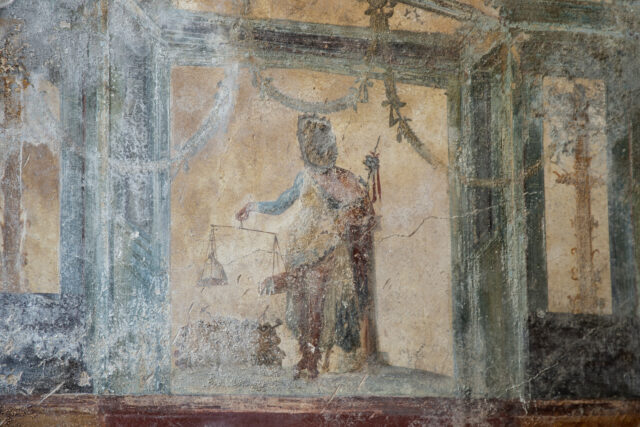Everyone knows the story of Pompeii, the ancient Roman city that was destroyed in 79 AD following the eruption of Mount Vesuvius. The entire area was covered in a layer of volcanic material, and as archaeologists excavated the area, they continued to find hidden treasures from beneath the rubble. The latest includes a brightly colored fresco that looks like a hung painting on a wall.
Discovering the fresco
Images of Greek mythological characters Phrixus and Helle, a pair of siblings who sought refuge at sea, have been found at the House of Leda in the ancient Roman city of Pompeii, which was destroyed in A.D. 79 by the infamous eruption of Mt. Vesuvius.https://t.co/YVF0oGNf4u pic.twitter.com/VDyrxvDVud
— Archaeology Magazine (@archaeologymag) March 6, 2024
The vibrant fresco was discovered in the House of Leda at the Archaeological Park of Pompeii. It was burned beneath a veil of volcanic material caused by the eruption of Mount Vesuvius in 79 AD and is considerably well-preserved, considering its age. It was revealed by the Pompeii Archaeological Park, the government-backed organization that manages the site and its excavations.
The fresco was discovered to have been painted as though it were a framed picture itself, hung upon a bright yellow wall. However, while the piece is in good condition, it is not entirely intact. The top right corner of the painting is missing and there are two major cracks that run through the center. Still, what is left is remarkable in its condition.
British archaeologist Dr. Sophie Hay, who works at the Archaeological Park of Pompeii, called the discovery “magical.” She said, “Witnessing the vibrant colours of freshly uncovered frescoes at Pompeii is a privilege and joy that never fades.” In respect to the fresco itself, she said, “Seeing the latest discovery of a mythological scene – Phrixus seated on a ram while his sister Helle drowns – in the context of the room it decorated is no exception.”
The myth of Phrixus and Helle

The scene depicted in the fresco is a tale from Greek mythology. It shows Phrixus and Helle, two twins, as they travel across the sea on a golden-fleeced ram while fleeing from their stepmother. In the fresco, Phrixus is seen sitting upon the ram, while Helle is reaching up to her brother after falling off of the magical creature.
The myth says that the twins were forced to flee their evil stepmother, Ino, after discovering she was trying to have them killed. As they are fleeing, they ride the magical ram who is capable of flying and swimming, but as they attempt to cross the strait, Helle falls off. She reaches for her brother, but her attempts fail, and she eventually drowns. Phrixus makes it safely to a region called Colchis, where he sacrifices the ram to Zeus. Zeus then places the sacrifice into the heavens, creating the constellation.
The House of Leda

While the discovery itself is a surprise, it is unsurprising it was found in the House of Leda. Excavations in the House of Leda took place as early as the 18th century and were eventually relaunched in 2018. The site is known for its intricate wall paintings, so it seems only fitting that this remarkable discovery was found within its walls.
However, a classics lecturer at the University of Oxford, Dr. Andrew Sillett, provided a reminder that not every piece of art in the house depicts the same epic scenes as this fresco. “In the entrance hall visitors are greeted by a large painting of Priapus, a fertility god, placing his enormous [expletive] on a set of scales to see how it measures up to the fruits of that year’s harvest,” he explained. This is a stark difference than the scene of Phrixus and Helle.
Read more: The Brilliant Reason the Old Masters Used Eggs in Their Paintings
Moving forward, experts hope to see the fresco safely put on display for the public to view.
